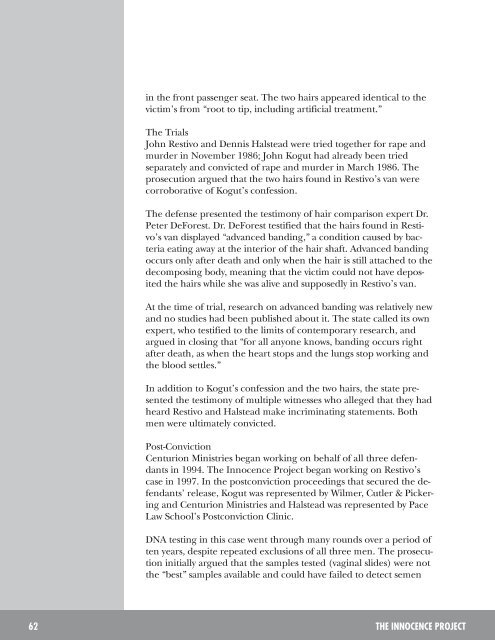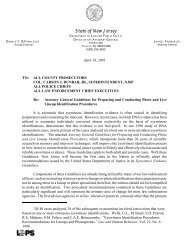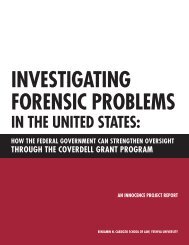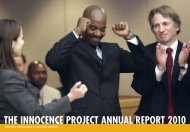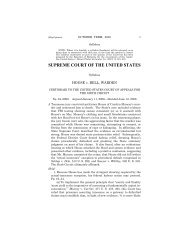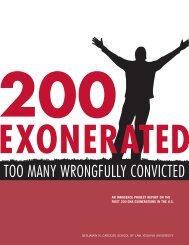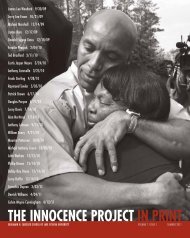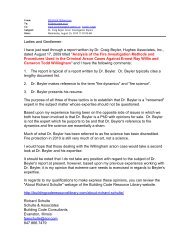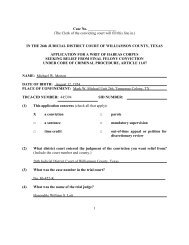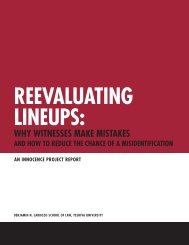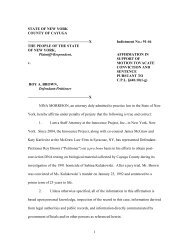Lessons Not Learned - The Innocence Project
Lessons Not Learned - The Innocence Project
Lessons Not Learned - The Innocence Project
You also want an ePaper? Increase the reach of your titles
YUMPU automatically turns print PDFs into web optimized ePapers that Google loves.
in the front passenger seat. <strong>The</strong> two hairs appeared identical to the<br />
victim’s from “root to tip, including artificial treatment.”<br />
<strong>The</strong> Trials<br />
John Restivo and Dennis Halstead were tried together for rape and<br />
murder in November 1986; John Kogut had already been tried<br />
separately and convicted of rape and murder in March 1986. <strong>The</strong><br />
prosecution argued that the two hairs found in Restivo’s van were<br />
corroborative of Kogut’s confession.<br />
<strong>The</strong> defense presented the testimony of hair comparison expert Dr.<br />
Peter DeForest. Dr. DeForest testified that the hairs found in Restivo’s<br />
van displayed “advanced banding,” a condition caused by bacteria<br />
eating away at the interior of the hair shaft. Advanced banding<br />
occurs only after death and only when the hair is still attached to the<br />
decomposing body, meaning that the victim could not have deposited<br />
the hairs while she was alive and supposedly in Restivo’s van.<br />
At the time of trial, research on advanced banding was relatively new<br />
and no studies had been published about it. <strong>The</strong> state called its own<br />
expert, who testified to the limits of contemporary research, and<br />
argued in closing that “for all anyone knows, banding occurs right<br />
after death, as when the heart stops and the lungs stop working and<br />
the blood settles.”<br />
In addition to Kogut’s confession and the two hairs, the state presented<br />
the testimony of multiple witnesses who alleged that they had<br />
heard Restivo and Halstead make incriminating statements. Both<br />
men were ultimately convicted.<br />
Post-Conviction<br />
Centurion Ministries began working on behalf of all three defendants<br />
in 1994. <strong>The</strong> <strong>Innocence</strong> <strong>Project</strong> began working on Restivo’s<br />
case in 1997. In the postconviction proceedings that secured the defendants’<br />
release, Kogut was represented by Wilmer, Cutler & Pickering<br />
and Centurion Ministries and Halstead was represented by Pace<br />
Law School’s Postconviction Clinic.<br />
DNA testing in this case went through many rounds over a period of<br />
ten years, despite repeated exclusions of all three men. <strong>The</strong> prosecution<br />
initially argued that the samples tested (vaginal slides) were not<br />
the “best” samples available and could have failed to detect semen<br />
62 THe InnoCenCe PRoJeCT


